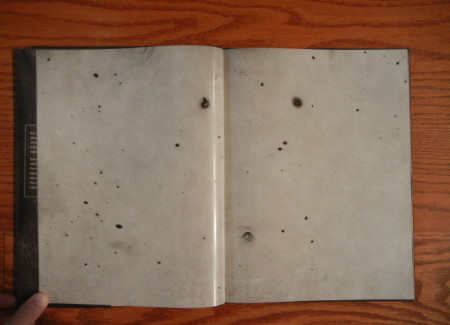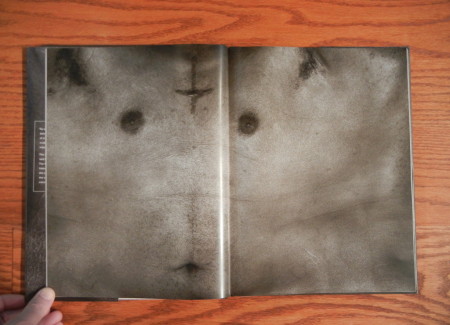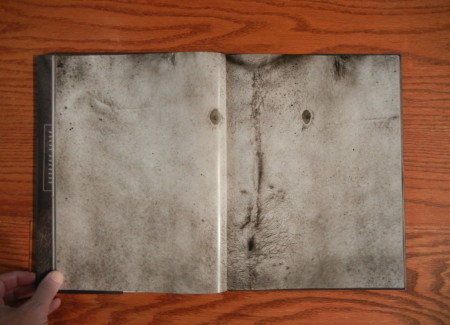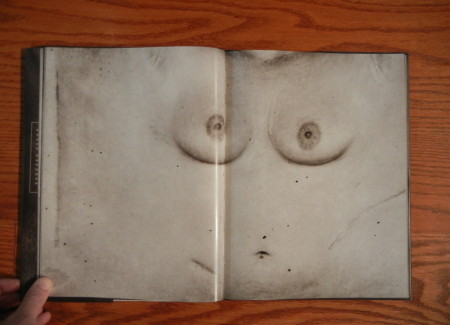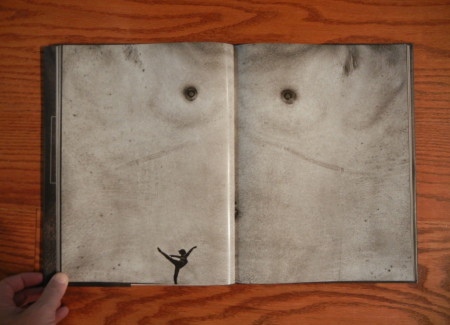JTF (just the facts): Published by Chroma Publications/The Arts at the California Institute of Integral Studies in 2014 (here). Harcover, 72 pages, with 30 color reproductions. Includes an essay by Tina Takemoto and a grid of thumbnails. (Cover and spread shots below.)
Comments/Context: When we try to describe the unique way a camera sees the world, we often talk about how it ruthlessly collapses whatever is put in front of the lens into two dimensions, in effect flattening the depth of the space arrayed before it. Across the history of the medium, photographers interested in the nude form have taken full advantage of this technical reality, turning the curves of male and female bodies alike into pared down, almost abstract exercises in elemental line and form. Fragments of bodies have famously become criss-crossed arcs, or undulating horizons, or triangulated space.
What’s exciting about June Yong Lee’s innovative new nudes is that he has taken full advantage of this well understood photographic flattening, but done so in a way that captures surface not contour. His images are digital composites of multiple frames taken around each sitter (consistently documenting the cropped down torso area from roughly armpit to hip), brought together in single contiguous sheets, as if the skin had been deflated, clinically removed, and spread out for close inspection like an animal hide. The photographs are like nothing we have ever seen before, and at first glance, are altogether unsettling, given the grim ideas of skinning and flaying that jump to mind. But with some patience, his pictures quiet down and evolve into intimate studies of the surprisingly varied topography of skin, becoming something akin to human maps that tell the private stories of their anonymous owners.
When we are forced to slow down and really look at skin in this way, it meets our gaze with unexpected nuance and subtlety. Anchored by nipples and belly buttons, Lee’s wide expanses of skin are covered in tiny hair follicles, decorated by spots, moles, freckles, and birthmarks, and steeped in the muted luminous tints of varied skin color. Lifestyle and history make their mark with simple underwear impressions, muscle indentations, and tan lines, as well as the deeper creased evidence of stretch marks, weight loss, and medical scars. Outward facing personality comes through in the piercings and tattoos, the ink art running the gamut from angry anarchy symbols and inspirational words to delicate butterflies, angel fish, and ballet dancers. Seen together, the tactile textures and patterns of the flesh become a kind of unexpected personal diary, full of anecdotes and plausible stories.
Strangely enough, the intricate investigation of skin hasn’t been a major feature in the history of the photographic nude. While the stately wrinkles of Bill Brandt’s artist eye portraits, John Coplans’ aging body, or Nicholas Nixon’s up close faces have offered unflinching evidence of the passing of time, few nudes are (or have been) first and foremost “about” skin. Recent works by Cara Phillips and Carla van de Puttelaar have investigated the details of skin with more intelligence and intensity, using ultraviolet filters and the freshness of clear morning light to unveil some of the hidden beauty hiding within. But Lee’s pictures push this interest much further, turning skin into a source of historical narrative and surface into a marker of identity.
While I think there is an obvious, instinctual reaction leading to seeing the freakish, fetish side of these pictures (mostly because we aren’t used to seeing anyone’s skin displayed in this unnatural way), Lee’s photographs deserve to be recognized as more than oddball curiosities. He’s used digital technology to smartly explore a facet of the nude that we have often overlooked, and discovered in it new ways to use bodies to tell stories. His images may challenge us with their frank “exposure”, but that uncertainty is evidence that he has successfully extended the boundaries of the genre. He’s effectively turned our bodies into pockmarked, peeling paint, graffiti covered urban walls and given them intense Siskind-like attention, allowing their features and markings to elegantly float between abstraction and recognizability.
Collector’s POV: June Yong Lee does not appear to have gallery representation at this time. Interested collectors should likely follow up directly with the photographer via his website (linked in the sidebar).


